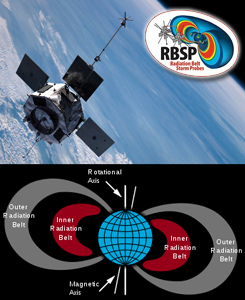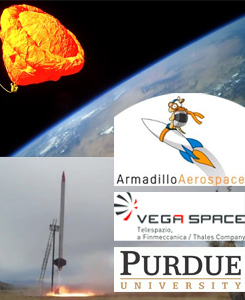Twin Probes Investigate Radiation Belts to Advance Scientific Understanding, Space Exploration
 The NASA Radiation Belt Storm Probes (RBSP) mission is set to launch aboard a United Launch Alliance Atlas V rocket at 04:08 EDT on August 23 from Space Launch Complex 41 at Cape Canaveral Air Force Station in Florida. The mission, scheduled to last 2 years at a cost of over US $600 million, will explore the most violent regions of near-Earth space: the Van Allen radiation belts, two doughnut-shaped rings of very high energy electrons and protons. The belts lie close to Earth, sandwiched between satellites in geostationary orbit above and satellites in low Earth orbit below. Two identical RBSP spacecraft, each weighing 670 kg and carrying the most comprehensive instrumentation ever sent into the radiation belts, will follow similar paths taking them through the inner and outer belts in highly elliptical orbits ranging from 600-37,000 km in altitude. The probes will investigate changes in Earth’s space environment caused by the Sun that can disable satellites, create power grid failures, disrupt GPS service and pose serious risks to crew aboard the International Space Station. They will also enable researchers to understand fundamental radiation and particle acceleration processes throughout the universe via three-dimensional imaging. (Image Credits: NASA, JHU Applied Physics Laboratory)
The NASA Radiation Belt Storm Probes (RBSP) mission is set to launch aboard a United Launch Alliance Atlas V rocket at 04:08 EDT on August 23 from Space Launch Complex 41 at Cape Canaveral Air Force Station in Florida. The mission, scheduled to last 2 years at a cost of over US $600 million, will explore the most violent regions of near-Earth space: the Van Allen radiation belts, two doughnut-shaped rings of very high energy electrons and protons. The belts lie close to Earth, sandwiched between satellites in geostationary orbit above and satellites in low Earth orbit below. Two identical RBSP spacecraft, each weighing 670 kg and carrying the most comprehensive instrumentation ever sent into the radiation belts, will follow similar paths taking them through the inner and outer belts in highly elliptical orbits ranging from 600-37,000 km in altitude. The probes will investigate changes in Earth’s space environment caused by the Sun that can disable satellites, create power grid failures, disrupt GPS service and pose serious risks to crew aboard the International Space Station. They will also enable researchers to understand fundamental radiation and particle acceleration processes throughout the universe via three-dimensional imaging. (Image Credits: NASA, JHU Applied Physics Laboratory)
Armadillo Aerospace Set for Commercial Payload Launch of STIG-B From Spaceport America
 At the frontier of the NewSpace industry, Armadillo Aerospace is developing reusable rocket powered vehicles with a focus on Vertical Takeoff, Vertical Landing capabilities. Ongoing efforts are centered on suborbital research and passenger flights using the Suborbital Transport with Inertial Guidance (STIG) rockets. The newly commissioned STIG-B is designed to fly 50kg payloads to a 100-km altitude or 5kg payloads to 150-km altitude using liquid oxygen and ethanol fuel. In early September, Armadillo is expected to conduct its first official launch from Spaceport America in New Mexico under a new 2-year FAA issued Operator Launch License. The STIG-B-1 mission will carry two payloads to 100km and provide a 3-minute opportunity window for experiments to be conducted in the microgravity environment of space. If successful the launch will qualify the STIG-B for the NASA Flight Opportunities Program. The revenue generating payloads are being flown for Vega Space, originally a German firm now part of the Italy-based space services company Telespazio, and University of Purdue, which has a renowned School of Aeronautics and Astronautics in Indiana, USA that counts Neil Armstrong, Eugene Cernan and Gus Grissom among its alumni. Approximately 37 percent of all USA human space flights have included a Purdue alumnus. (Image Credits: Armadillo Aerospace, Vega Space, Purdue University)
At the frontier of the NewSpace industry, Armadillo Aerospace is developing reusable rocket powered vehicles with a focus on Vertical Takeoff, Vertical Landing capabilities. Ongoing efforts are centered on suborbital research and passenger flights using the Suborbital Transport with Inertial Guidance (STIG) rockets. The newly commissioned STIG-B is designed to fly 50kg payloads to a 100-km altitude or 5kg payloads to 150-km altitude using liquid oxygen and ethanol fuel. In early September, Armadillo is expected to conduct its first official launch from Spaceport America in New Mexico under a new 2-year FAA issued Operator Launch License. The STIG-B-1 mission will carry two payloads to 100km and provide a 3-minute opportunity window for experiments to be conducted in the microgravity environment of space. If successful the launch will qualify the STIG-B for the NASA Flight Opportunities Program. The revenue generating payloads are being flown for Vega Space, originally a German firm now part of the Italy-based space services company Telespazio, and University of Purdue, which has a renowned School of Aeronautics and Astronautics in Indiana, USA that counts Neil Armstrong, Eugene Cernan and Gus Grissom among its alumni. Approximately 37 percent of all USA human space flights have included a Purdue alumnus. (Image Credits: Armadillo Aerospace, Vega Space, Purdue University)

![]() = All times for terrestrial events in local time unless noted.
= All times for terrestrial events in local time unless noted.
![]() = All times for international terrestrial events in local time unless noted.
= All times for international terrestrial events in local time unless noted.
![]() = All times for space events, and…
= All times for space events, and…
![]() = All times for international space / astro events in Hawaii Standard Time unless noted. Add 10 hours to obtain UT (‘Universal Time;’ Greenwich, England).
= All times for international space / astro events in Hawaii Standard Time unless noted. Add 10 hours to obtain UT (‘Universal Time;’ Greenwich, England).
Weekly Planet Watch – Evening Planets: Mars (WSW), Saturn (WSW). Morning Planets: Mercury (ENE), Venus (E), Jupiter (SE).
MONDAY
![]() Aug 20 — ISS, LEO: Expedition 32 Commander Gennady Padalka and Flight Engineer Yuri Malenchenko to conduct 163rd spacewalk in support of space station assembly and maintenance, broadcast live on NASA TV.
Aug 20 — ISS, LEO: Expedition 32 Commander Gennady Padalka and Flight Engineer Yuri Malenchenko to conduct 163rd spacewalk in support of space station assembly and maintenance, broadcast live on NASA TV.
![]() Aug 20 — Curiosity, Red Planet: Preparing / testing motor controllers for its first drive on Mars this week, likely to include short forward and reverse segments and a turn.
Aug 20 — Curiosity, Red Planet: Preparing / testing motor controllers for its first drive on Mars this week, likely to include short forward and reverse segments and a turn.
![]() Aug 20 — Dawn Mission, Main Asteroid Belt: Dawn spacecraft departure for Ceres set for NET Sep 5 after equipment used to maintain position in space malfunctioned before spacecraft could leave Vesta.
Aug 20 — Dawn Mission, Main Asteroid Belt: Dawn spacecraft departure for Ceres set for NET Sep 5 after equipment used to maintain position in space malfunctioned before spacecraft could leave Vesta.
![]() Aug 20 — XCOR Aerospace, Mojave CA: First XCOR Lynx test flights could begin as early as end of 2012, with first revenue flights potentially to come by end of 2013.
Aug 20 — XCOR Aerospace, Mojave CA: First XCOR Lynx test flights could begin as early as end of 2012, with first revenue flights potentially to come by end of 2013.
![]() Aug 20 — Sierra Nevada Corporation, Sparks NV: Mark Sirangelo, Space Systems division head, sees 3 alternative markets for its Dream Chaser: servicing other spacecraft in LEO, long-duration / autonomous orbital sojourns and orbital tourism.
Aug 20 — Sierra Nevada Corporation, Sparks NV: Mark Sirangelo, Space Systems division head, sees 3 alternative markets for its Dream Chaser: servicing other spacecraft in LEO, long-duration / autonomous orbital sojourns and orbital tourism.
![]() Aug 20 — SpaceX, Hawthorne CA: Founder, CEO and chief designer Elon Musk confident first human Mars mission can happen in next 12-15 years.
Aug 20 — SpaceX, Hawthorne CA: Founder, CEO and chief designer Elon Musk confident first human Mars mission can happen in next 12-15 years.
![]() Aug 20-24 — International Astronomical Union, Beijing, China: ‘IAU Symposium 288: Astrophysics from Antarctica.’
Aug 20-24 — International Astronomical Union, Beijing, China: ‘IAU Symposium 288: Astrophysics from Antarctica.’
![]() Aug 20-31 — International Astronomical Union, Beijing, China: ‘28th IAU General Assembly.’
Aug 20-31 — International Astronomical Union, Beijing, China: ‘28th IAU General Assembly.’
![]() Aug 20 — Asteroid 2012 EC: Near-Earth Flyby (0.081 AU).
Aug 20 — Asteroid 2012 EC: Near-Earth Flyby (0.081 AU).
![]() Aug 20 — Asteroid 2008 QB: Near-Earth Flyby (0.091 AU).
Aug 20 — Asteroid 2008 QB: Near-Earth Flyby (0.091 AU).
Continued from…
![]() Aug 19-24 — The Chinese Society of Theoretical and Applied Mechanics, Beijing, China: ‘23rd International Congress of Theoretical and Applied Mechanics (ICTAM2012).’
Aug 19-24 — The Chinese Society of Theoretical and Applied Mechanics, Beijing, China: ‘23rd International Congress of Theoretical and Applied Mechanics (ICTAM2012).’
TUESDAY
![]() Aug 21 — The Space Foundation, Secure World Foundation, Washington DC: ‘Defense & Industry on Space Cooperation;’ Congressional briefing to discuss current international initiatives aimed at outer space security and sustainability.
Aug 21 — The Space Foundation, Secure World Foundation, Washington DC: ‘Defense & Industry on Space Cooperation;’ Congressional briefing to discuss current international initiatives aimed at outer space security and sustainability.
![]() Aug 21 — Moon: 1.1° SSE of Spica, 13:00; 5.2° SSW of Saturn, 14:00; 2.4° SW of Mars, 19:00.
Aug 21 — Moon: 1.1° SSE of Spica, 13:00; 5.2° SSW of Saturn, 14:00; 2.4° SW of Mars, 19:00.
WEDNESDAY
![]() Aug 22-23 — NASA, Kennedy Space Center FL: ‘NASA Tweet-up Event for Social Media Followers at RBSP Launch .’
Aug 22-23 — NASA, Kennedy Space Center FL: ‘NASA Tweet-up Event for Social Media Followers at RBSP Launch .’
![]() Aug 22 — SETI Institute, Mountain View CA: Colloquium: ‘Radio Anatomy of Saturn’s Rings with Cassini,’ presented by Essam Marouf, San Jose State University.
Aug 22 — SETI Institute, Mountain View CA: Colloquium: ‘Radio Anatomy of Saturn’s Rings with Cassini,’ presented by Essam Marouf, San Jose State University.
THURSDAY
![]() NET Aug 23 — ULA, Launch Atlas 5 / RBSP, Cape Canaveral FL: A ULA Atlas 5 rocket set to launch Radiation Belt Storm Probes mission for NASA: 2 spacecraft to fly in highly elliptical orbits to study Earth’s radiation belts and probe influences of Sun; 04:08 EDT.
NET Aug 23 — ULA, Launch Atlas 5 / RBSP, Cape Canaveral FL: A ULA Atlas 5 rocket set to launch Radiation Belt Storm Probes mission for NASA: 2 spacecraft to fly in highly elliptical orbits to study Earth’s radiation belts and probe influences of Sun; 04:08 EDT.
FRIDAY
![]() Aug 24 — Lunar and Planetary Institute, University Space Research Association, University of California at Berkeley, Houston TX: ‘First Results from the ARTEMIS Mission: The Moon’s Sphere of Influence.’
Aug 24 — Lunar and Planetary Institute, University Space Research Association, University of California at Berkeley, Houston TX: ‘First Results from the ARTEMIS Mission: The Moon’s Sphere of Influence.’
![]() Aug 24 — The Bruce and Astrid McWilliams Center for Cosmology at Carnegie Mellon University, Pittsburgh PA: ‘Workshop on Cosmic Acceleration.’
Aug 24 — The Bruce and Astrid McWilliams Center for Cosmology at Carnegie Mellon University, Pittsburgh PA: ‘Workshop on Cosmic Acceleration.’
![]() Aug 24-26 — Clay Center Observatory, Brookline MA: ‘From Climate to Space: Hot Topics for the Station Scientist.’
Aug 24-26 — Clay Center Observatory, Brookline MA: ‘From Climate to Space: Hot Topics for the Station Scientist.’
![]() Aug 24 — Moon: First quarter, 3:54; 5.4° SW of Antares, 16:00.
Aug 24 — Moon: First quarter, 3:54; 5.4° SW of Antares, 16:00.
SATURDAY
![]() Aug 25-27 — The International Space Elevator Consortium, Redmond WA: ‘2012 Space Elevator Conference.’
Aug 25-27 — The International Space Elevator Consortium, Redmond WA: ‘2012 Space Elevator Conference.’
![]() Aug 25 – Sep 1 — International Society for Photogrammetry and Remote Sensing (ISPRS), Melbourne, Australia: ‘22nd Congress of the ISPRS.’
Aug 25 – Sep 1 — International Society for Photogrammetry and Remote Sensing (ISPRS), Melbourne, Australia: ‘22nd Congress of the ISPRS.’
![]() Aug 25 — Mars Society UK, Leicester, England: ‘Mars Society UK Annual Conference.’
Aug 25 — Mars Society UK, Leicester, England: ‘Mars Society UK Annual Conference.’
![]() Aug 25 — Northern Iota Aquarids Meteor Shower Peak: Appearing to radiate from constellation Aquarius, shower produces 5-10 meteors per hour.
Aug 25 — Northern Iota Aquarids Meteor Shower Peak: Appearing to radiate from constellation Aquarius, shower produces 5-10 meteors per hour.
![]() Aug 25 — Asteroid 2012 FM52: Near-Earth Flyby (0.060 AU).
Aug 25 — Asteroid 2012 FM52: Near-Earth Flyby (0.060 AU).
SUNDAY
![]() Aug 26-28 – Sep 1 — ESA, The European Space Research and Technology Centre, Noordwijk, The Netherlands: ‘Fourth International Workshop on Analogue and Mixed Signal Integrated Circuits for Space Applications (AMICSA).’
Aug 26-28 – Sep 1 — ESA, The European Space Research and Technology Centre, Noordwijk, The Netherlands: ‘Fourth International Workshop on Analogue and Mixed Signal Integrated Circuits for Space Applications (AMICSA).’